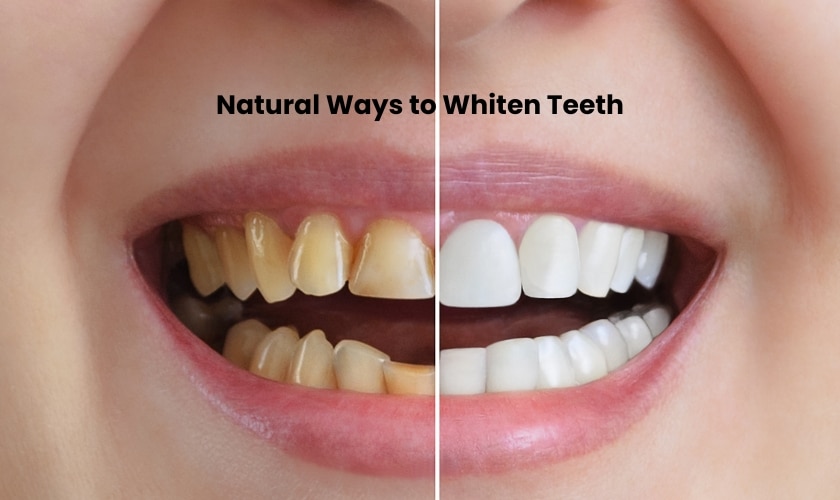
A dazzling smile is a powerful confidence booster. But over time, teeth can become stained from coffee, red wine, and even everyday foods. While commercial teeth whitening strips and treatments offer a quick fix, they often contain harsh chemicals that can irritate gums and damage enamel.
Fortunately, there are plenty of safe and effective natural ways to whiten teeth at home. This comprehensive guide explores the best natural methods, how they work, and additional tips for a healthier, brighter smile.
Why Do Teeth Get Stained?
Teeth have two main layers: the inner dentin, which determines their yellow hue, and the outer enamel, a white, protective layer. Over time, the enamel can become stained by:
- Chromogens: These pigmented compounds found in coffee, tea, red wine, and dark berries adhere to the enamel.
- Fluorosis: Excessive fluoride intake during childhood can cause white streaks or mottling on teeth.
- Smoking: Tar and nicotine from cigarettes stain teeth yellow or brown.
- Medications: Certain antibiotics and medications can also discolor teeth.
Natural Ways to Whiten Teeth
Nature provides several alternatives to harsh chemical whiteners. Here are some effective methods you can incorporate into your routine:
1. Brushing with Baking Soda
Baking soda is a gentle abrasive that can help scrub away surface stains. Studies like one published in 2017 in the Journal of Dentistry show it to be safe and effective for whitening teeth. Here’s how to use it:
- Make a paste by mixing 1 teaspoon of baking soda with a little water.
- Brush your teeth with the paste for 1-2 minutes, focusing on stained areas.
- Rinse thoroughly with water.
Note: Don’t use baking soda too frequently, as it can be abrasive. Limit its use to 1-2 times a week.
2. Hydrogen Peroxide Power
Hydrogen peroxide is a natural bleaching agent that can lighten tooth stains. However, it can also cause sensitivity. Here’s how to use it cautiously:
- Mix equal parts 3% hydrogen peroxide solution with water.
- Swish for 30 seconds, then rinse thoroughly.
Use hydrogen peroxide sparingly, and discontinue if you experience any sensitivity.
3. The Crunchy Power of Fruits and Vegetables
Eating crunchy fruits and vegetables like apples, pears, celery, and carrots increases saliva production. Saliva acts as a natural mouthwash, washing away food particles and preventing stain buildup.
While some claim strawberries and pineapples have whitening properties, research is limited. However, including them in your diet for their overall health benefits can’t hurt!
4. Harnessing the Power of Coconut Oil
Oil pulling, an ancient Ayurvedic practice, involves swishing oil in your mouth to remove bacteria and toxins. Coconut oil, with its antimicrobial properties, is a popular choice. Here’s how to try it:
- Put a tablespoon of virgin coconut oil in your mouth.
- Swish thoroughly for 15-20 minutes.
- Spit it out and rinse with warm water.
5. Brushing and Flossing Regularly
This might seem obvious, but proper oral hygiene is crucial for maintaining white teeth. Brush your teeth twice daily for two minutes with a fluoride toothpaste. Floss daily to remove plaque and food particles from between teeth.
Here’s a table summarizing these natural whitening methods:
| Method | How it Works | Usage Tips |
| Baking Soda | Gently abrades surface stains | Use a paste 1-2 times a week |
| Hydrogen Peroxide | Bleaches stains | Dilute with water, use sparingly |
| Fruits & Vegetables | Increase saliva production to wash away stains | Part of a healthy diet |
| Coconut Oil Pulling | May remove bacteria and toxins | Research on whitening benefits inconclusive |
| Brushing & Flossing | Removes plaque and prevents stain buildup | Brush twice daily, floss daily |
Conclusion: A Brighter, Healthier You
By incorporating these natural teeth whitening methods alongside a consistent oral hygiene routine recommended by your dentist Beaverton, you can achieve a healthy, brighter smile naturally. Remember, consistency is key! Patience and a commitment to good oral health, including regular dental checkups and cleanings, will help you unlock the confidence that comes with a sparkling smile.
Unlike commercial treatments, natural methods take time and consistency to show results. You might see a slight improvement within a few weeks, but significant whitening may take several months. Patience and consistent use are key.
While generally safe, some methods may cause sensitivity. If you experience discomfort, discontinue use and consult your dentist. People with sensitive teeth, gum disease, or damaged enamel should consult a dentist before trying any whitening methods.
If you desire faster or more dramatic results, consult your dentist about professional whitening treatments. These treatments use stronger bleaching agents and provide quicker results. However, they can also be more expensive and may cause temporary tooth sensitivity.
While generally safe, overuse of certain methods like baking soda can damage tooth enamel. It’s crucial to follow recommended usage guidelines. Additionally, some fruits with high acid content, like lemons, can erode enamel if used excessively for whitening purposes.
